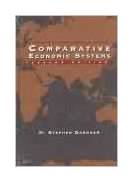|
||
• wydawnictwa polskie
• Zamów informacje o nowościach z wybranego tematu • kontakt
• Cookies na stronie |
COMARATIVE ECONOMIC SYSTEMGARDNERS S.wydawnictwo: DRYDEN , rok wydania 1997, wydanie IIcena netto: Comperative Economic Systems Preface These are the days of lasers in the jungle Lasers in the jungle somewhere Staccato signals of constant information A loose affiliation of millionaires... The way we look to a distant constellation That's dying in a corner of the sky These are the days of miracle and wonder And don't cry baby, don't cry PAUL SIMON, "THE BOY IN THE BUBBLE," GRACELAND,1986' According to scholarly tradition, the modem historical era began around 1500 a.d. Within fifty years of that date, the last citadel of ancient Rome was overthrown in Constantinople, a despotic Mongol regime collapsed in Russia, Christopher Columbus and Vasco da Gama created new links between Europe and the outside world, Gutenberg launched an era of mass communication, Copernicus rearranged the known universe, Luther and Calvin transformed the institutions of Christendom, and Michelangelo, Raphael, and da Vinci led a High Renaissance of the arts. Today, five centuries later, the world seems to be passing through another radical phase of reinvention. Left-wing and right-wing despotisms have fallen in Central Europe, Latin America, Africa, and Asia, clearing the way for unthinkable opportunities and unpredictable challenges. Communication technologies and trade agreements have unleashed the movement of information, ideas, people, and products. The world market is open for business. What is the current economic condition of the world and its regions? What historical, cultural, and ideological forces are shaping the economy of the future? What institutional options do we have as individuals, countries, and regions in an intensely competitive world? In Comparative Economic Systems, I attempt to provide the conceptual tools, historical background, and current information needed to explore these questions. This book is designed to serve as a basic text for undergraduates or as a supplementary survey text for graduate students. My approach is nontechnical; most of the book can be understood by readers with limited backgrounds in economics. This is important because all of usbusiness people, journalists, public servants, educators, and students-need to understand the rich diversity and mutability of economic institutions in the world around us. New AND distinctive features Although some important features of the first edition have been preserved, this edition of the book has been completely reorganized, expanded, updated, and rewritten to reflect the new and changing shape of the world economy. Several unique features should distinguish it from the first edition or from other books in the field. regional orientation, m the past, comparative economics texts were organized along ideological lines, emphasizing the differences between capitalist and socialist societies. Some authors have continued to emphasize ideological divisions, and I have addressed them in this book. Today, though, the more important distinctions between countries seem to be related to geography. If two countries are located in the same region, they are more likely to share elements of culture, climate, history, and colonial heritage, and they are more likely to be united by a free trade agreement or another international arrangement. Hence, I have reorganized this book along regional lines, with new chapters added to introduce the Western Hemisphere, Western Europe, Central Eurasia, South and East Asia, and Africa. Each of these chapters includes a survey of economic and cultural factors that unite and/or divide the region, and a survey of institutions promoting regional economic integration. broad country coverage. Many individual countries are given full-chapter coverage. These include the United States, Great Britain, Germany, Sweden, France, Japan, and China. Four chapters devoted to the transitional economies of the former Soviet Union and Central and Eastern Europe. Thus, instructors should be able to accommodate individual interests and time constraints. pedagogical approach. Conceptual material is integrated into chapters that discuss actual economies. The theory of the labor-managed firm, for example, is incorporated in our discussion of former Yugoslavia; input-output economics is connected to the former Soviet economy; the theory of the share economy is connected to Japan. When necessary, technical issues are discussed in chapter appendices. Several chapters also include boxed items to provide living applications of broader concepts. When possible, the country chapters follow a common outline to facilitate comparisons. Each chapter opens with a map, and includes a survey of economic institutions related to the socioeconomic environment, industrial organization, labor market and relations, financial sector, and the government. Key terms appear in bold type. Each chapter ends with a summary, a set of discussion questions, a list of suggesting readings, and a list of Internet resource. 756 pages Księgarnia nie działa. Nie odpowiadamy na pytania i nie realizujemy zamówien. Do odwolania !. |


